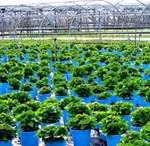The impact of pesticides on salmon populations
 Fish,
Fish,  Freshwater,
Freshwater,  Marine
Marine  Chinook salmon (Oncorhynchus tshawytscha). Image credit, National Park Service.Findings from a new study in the journal Ecological Applications indicate that short-term pesticide exposure in juvenile Chinook salmon is likely reducing population growth rates and impeding recovery of the species.
Chinook salmon (Oncorhynchus tshawytscha). Image credit, National Park Service.Findings from a new study in the journal Ecological Applications indicate that short-term pesticide exposure in juvenile Chinook salmon is likely reducing population growth rates and impeding recovery of the species.
David Baldwin and fellow researchers from NOAA developed a complex model that links the impacts of pesticides on individual fish with the overall trajectory of Chinook salmon populations.
Their model projects that seasonal exposures to four-day pulses of organophosphate insecticides over 20 years are sufficient to reduce the population of return spawners by 73% relative to an unexposed control population.
Extensive research over the years has documented that pesticide exposure can cause damage to salmon individuals. Exposure to organophosphates and carbamate insecticides can cause non-fatal impacts to fish by inhibiting activity in the nervous system. This in turn can impede the growth of juveniles.
While past research has shown that juvenile growth affects their survival rate in marine and freshwater environments, few studies have looked at how the toxic effects of pesticide exposure on individuals translate to impacts at the population level.
To help build our understanding of this issue, Baldwin and fellow researchers developed a model that considers two types of existing data:
1) Laboratory studies on the effects of pesticide exposure in juveniles on nervous system inhibition, feeding behavior, and growth.
2) Field studies linking relative size at migration to survival.
The researchers ran the model based on several exposure scenarios reflecting the transport of pesticides to salmon habitats via drift, surface runoff, and irrigation return flows.
The study authors warn that the model is probably overly simplistic given the lack of complete data and may overstate or understate the actual impacts somewhat. Nevertheless, the output from the model will help with the conservation of threatened and endangered populations. The authors write:
Establishing toxicological linkages across biological scales is necessary to (1) identify which chemicals in salmon habitats should be a priority for toxic reduction strategies; (2) place water quality in the appropriate context for relative risk comparisons with physical and biological forms of habitat degradation; (3) estimate the population-scale benefits of restoration projects that improve water quality; and (4) provide a basis for more sophisticated modeling analyses that focus on specific population segments and incorporate indirect effects (e.g., via food webs) and interactions between chemical and nonchemical stressors.
--Reviewed by Rob Goldstein
Baldwin, D., Spromberg, J., Collier, T., & Scholz, N. (2009). A fish of many scales: extrapolating sublethal pesticide exposures to the productivity of wild salmon populations Ecological Applications, 19 (8), 2004-2015 DOI: 10.1890/08-1891.1




Reader Comments